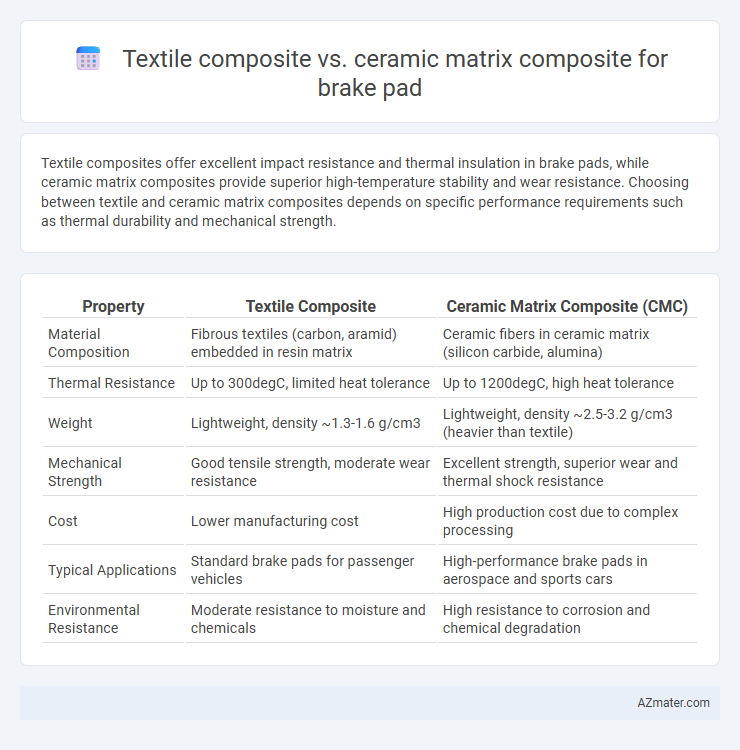Textile composites offer excellent impact resistance and thermal insulation in brake pads, while ceramic matrix composites provide superior high-temperature stability and wear resistance. Choosing between textile and ceramic matrix composites depends on specific performance requirements such as thermal durability and mechanical strength.
Table of Comparison
| Property | Textile Composite | Ceramic Matrix Composite (CMC) |
|---|---|---|
| Material Composition | Fibrous textiles (carbon, aramid) embedded in resin matrix | Ceramic fibers in ceramic matrix (silicon carbide, alumina) |
| Thermal Resistance | Up to 300degC, limited heat tolerance | Up to 1200degC, high heat tolerance |
| Weight | Lightweight, density ~1.3-1.6 g/cm3 | Lightweight, density ~2.5-3.2 g/cm3 (heavier than textile) |
| Mechanical Strength | Good tensile strength, moderate wear resistance | Excellent strength, superior wear and thermal shock resistance |
| Cost | Lower manufacturing cost | High production cost due to complex processing |
| Typical Applications | Standard brake pads for passenger vehicles | High-performance brake pads in aerospace and sports cars |
| Environmental Resistance | Moderate resistance to moisture and chemicals | High resistance to corrosion and chemical degradation |
Introduction to Brake Pad Materials
Textile composites and ceramic matrix composites represent advanced materials used in brake pad manufacturing, each offering distinct performance characteristics. Textile composites, often reinforced with aramid or carbon fibers, provide flexibility, thermal stability, and enhanced wear resistance, making them suitable for high-performance automotive and motorcycle applications. Ceramic matrix composites exhibit superior thermal conductivity, oxidation resistance, and structural integrity at elevated temperatures, ideal for high-speed braking systems in aerospace and motorsport industries.
Overview of Textile Composites
Textile composites for brake pads consist of woven or non-woven fiber reinforcements such as aramid, carbon, or glass fibers embedded in a polymer matrix, offering high strength-to-weight ratios and excellent thermal stability. These composites provide effective heat dissipation, wear resistance, and noise reduction, making them suitable for automotive and aerospace braking systems. Their manufacturing flexibility enables customization of mechanical properties and durability, often resulting in improved brake performance under varied operating conditions.
Overview of Ceramic Matrix Composites
Ceramic Matrix Composites (CMCs) are advanced materials composed of ceramic fibers embedded within a ceramic matrix, offering superior high-temperature resistance, low density, and excellent wear resistance compared to traditional textile composites. Their thermal stability and enhanced fracture toughness make CMCs ideal for brake pad applications in high-performance automotive and aerospace systems, where extreme heat and mechanical stress are common. The inherent lightweight nature of ceramic fibers such as silicon carbide or alumina improves braking efficiency while reducing overall vehicle weight, leading to improved fuel economy and performance.
Material Properties Comparison
Textile composites for brake pads offer high impact resistance and flexibility with moderate thermal stability, typically operating below 600degC, whereas ceramic matrix composites (CMCs) provide superior thermal resistance above 1000degC and exceptional wear resistance essential for high-performance braking applications. Textile composites generally have lower density and cost but exhibit reduced hardness and friction stability compared to CMCs, which maintain structural integrity under extreme temperatures with minimal oxidation. The enhanced thermal conductivity and mechanical strength of ceramic matrix composites enable improved braking efficiency and longevity in high-stress environments.
Performance Under High Temperatures
Textile composites exhibit moderate thermal stability and are prone to degradation under prolonged high temperatures, limiting their effectiveness in extreme brake pad applications. Ceramic matrix composites demonstrate superior thermal resistance withstanding temperatures above 1000degC while maintaining structural integrity and frictional performance. This makes ceramic matrix composites the preferred material for brake pads requiring durability and consistent performance in high-temperature environments.
Wear Resistance and Longevity
Textile composites exhibit moderate wear resistance but excel in flexibility and impact absorption, making them suitable for applications where vibration damping is critical. Ceramic matrix composites outperform textile composites with superior wear resistance and high-temperature stability, significantly enhancing brake pad longevity under extreme operating conditions. The integration of ceramic fibers within the matrix provides a durable structure that maintains frictional performance without rapid degradation.
Thermal Conductivity and Heat Dissipation
Textile composites used in brake pads typically exhibit lower thermal conductivity compared to ceramic matrix composites, resulting in slower heat dissipation during braking. Ceramic matrix composites offer high thermal conductivity, enabling rapid heat transfer and better temperature regulation under extreme braking conditions. Enhanced heat dissipation in ceramic matrix composites reduces brake fade and prolongs pad life, making them superior for performance-oriented applications.
Cost and Manufacturing Considerations
Textile composites offer lower manufacturing costs and simpler fabrication processes due to the use of woven fibers and conventional resin systems, making them cost-effective for brake pad production. Ceramic matrix composites involve higher material costs and complex manufacturing techniques like high-temperature sintering or chemical vapor infiltration, increasing production expenses. Cost-efficiency in textile composites favors mass production, while ceramic composites provide superior thermal and wear performance at a premium cost.
Environmental Impact and Sustainability
Textile composites in brake pads offer lower environmental impact due to their biodegradability and use of renewable fibers, reducing landfill waste and carbon emissions in production. Ceramic matrix composites provide superior heat resistance and durability, extending brake pad lifespan, which contributes to sustainability by minimizing replacement frequency and resource consumption. However, the high energy consumption and raw material extraction involved in ceramic composite manufacturing pose greater environmental challenges compared to textile composites.
Application Suitability: Which Composite is Best?
Textile composites offer excellent flexibility, abrasion resistance, and cost-effectiveness, making them suitable for standard automotive brake pads requiring moderate thermal stability and durability. Ceramic matrix composites excel in high-temperature resistance, structural integrity, and wear performance, making them ideal for high-performance brakes in aerospace and racing applications where extreme heat and friction are encountered. Selecting the best composite depends on the operating environment, with textile composites favored for everyday vehicles and ceramic matrix composites preferred for high-stress, high-temperature braking systems.

Infographic: Textile composite vs Ceramic matrix composite for Brake pad
 azmater.com
azmater.com